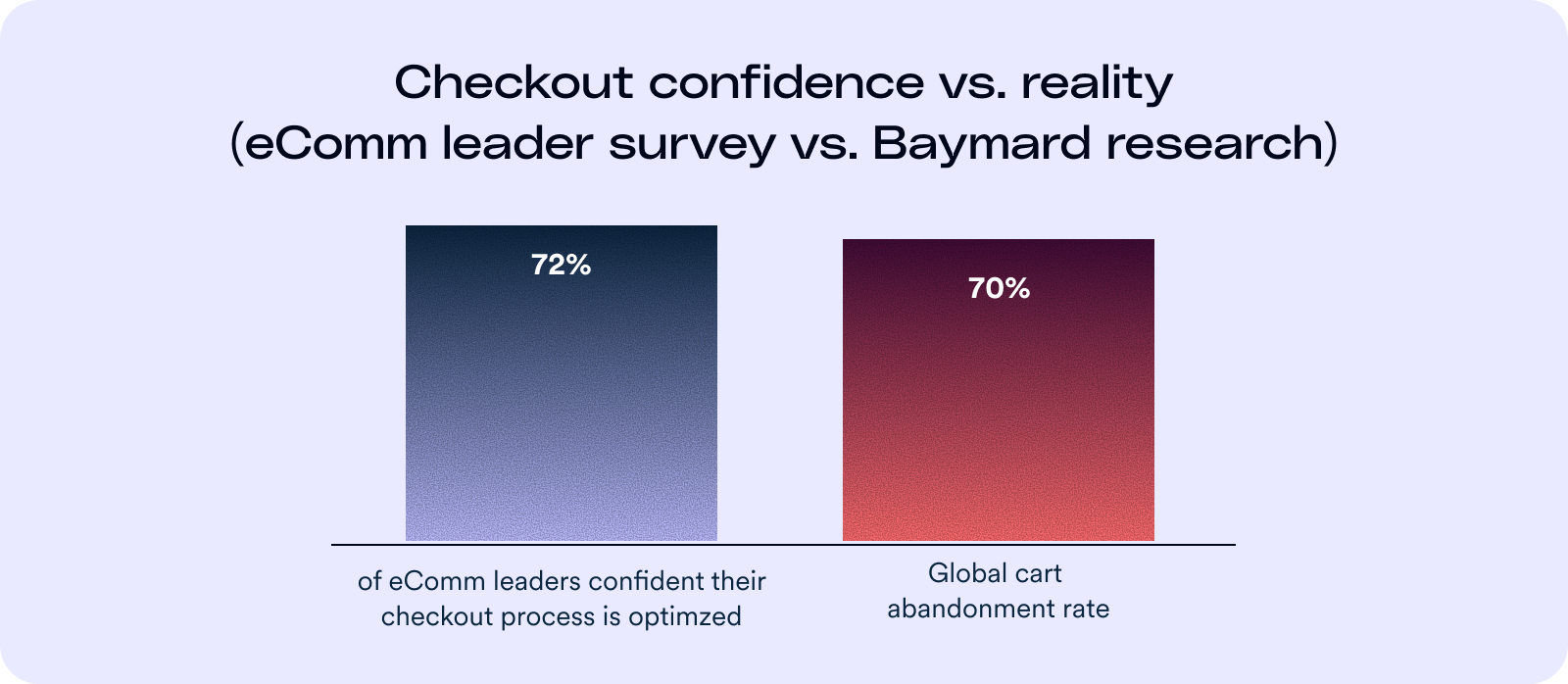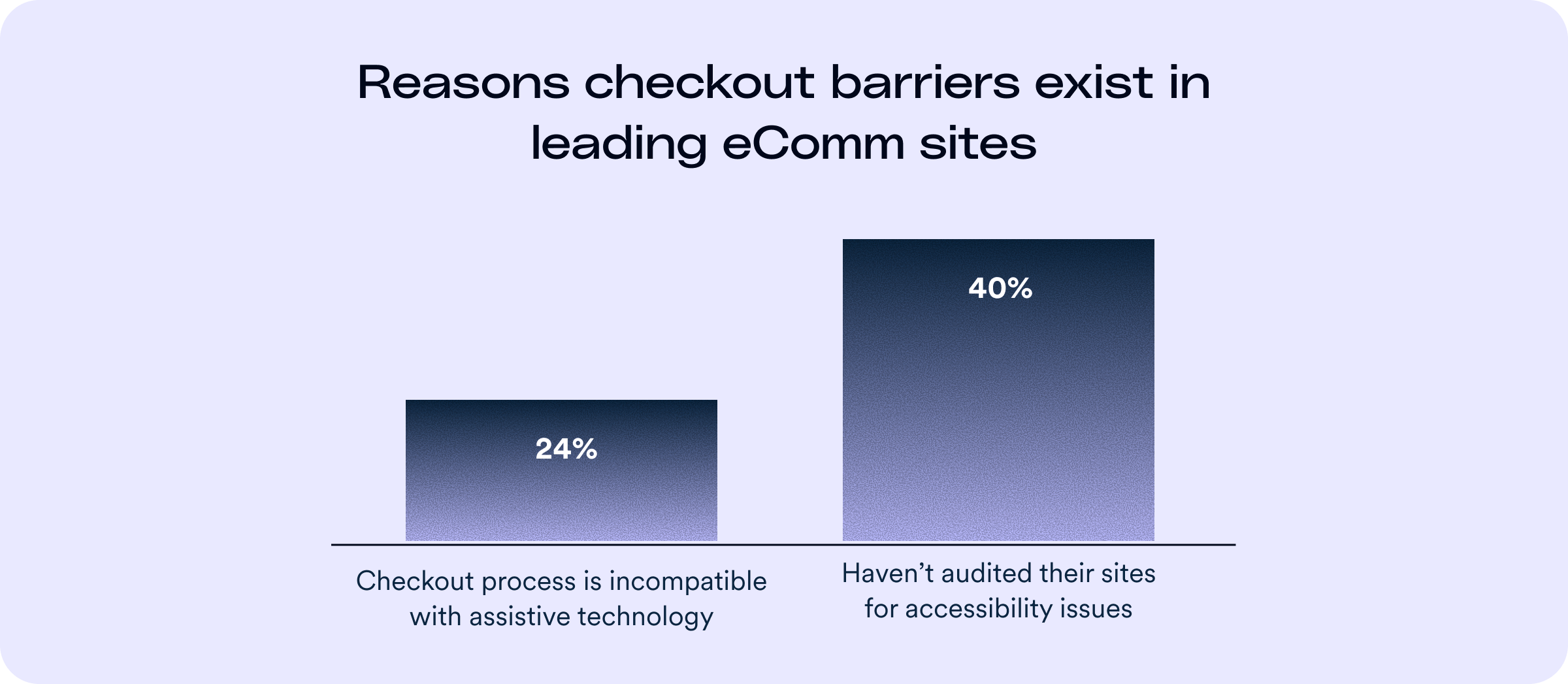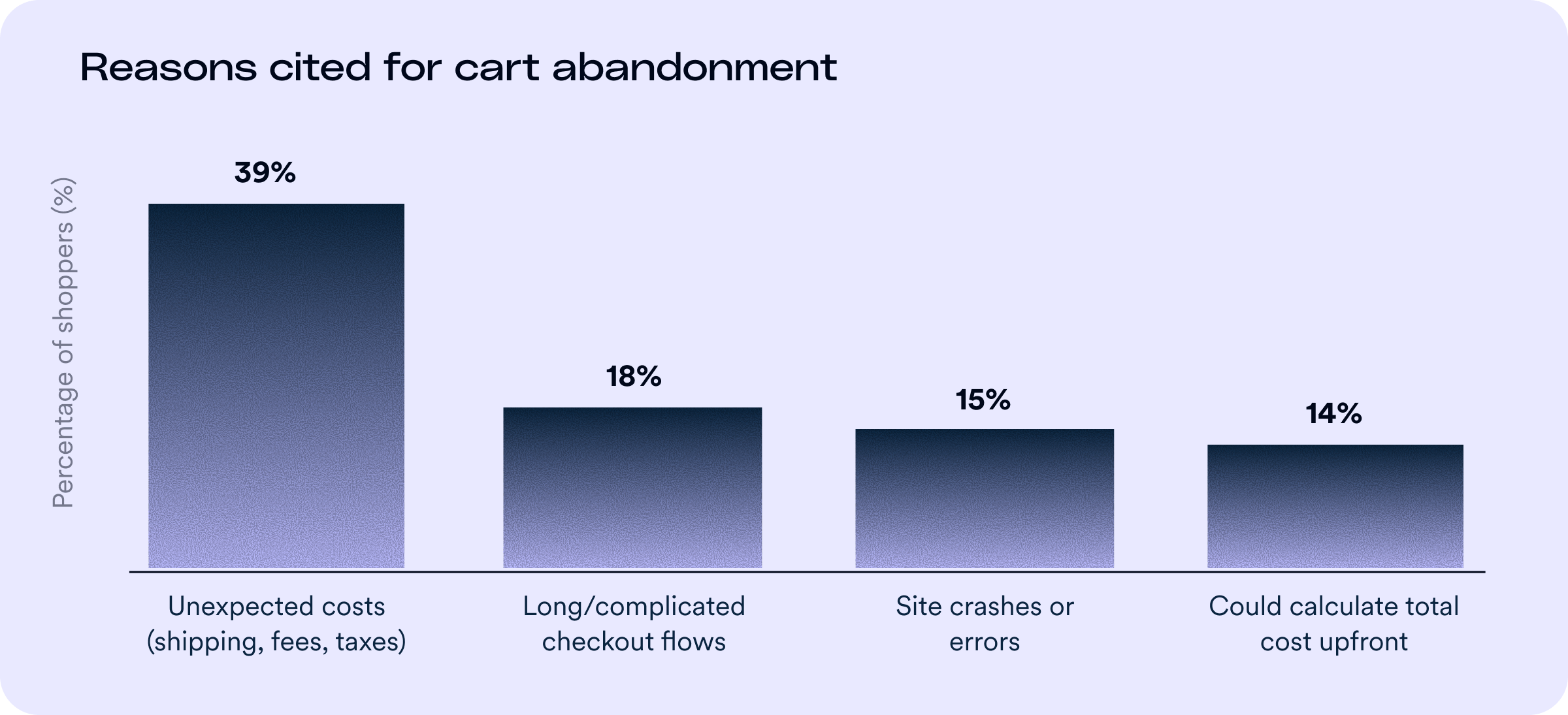About the research
Our eCommerce trends survey, conducted with Qualtrics, non-profit leaders, and disability community organizations, captured insights from over 300 eCommerce leaders and members of the disability community. The findings reveal a clear connection between accessibility and revenue: most checkout friction points that drive cart abandonment are also accessibility failures, showing why accessibility must be treated as a core conversion strategy.
Why cart abandonment isn’t inevitable
For years, eCommerce leaders have accepted high cart abandonment rates as a cost of doing business. But the numbers reveal something else. Across 49 studies, the global average cart abandonment rate sits at 70.19%, making it the single largest source of lost revenue in digital commerce. Baymard researchers estimate that $260 billion in sales could be recovered simply by improving checkout usability.
89% of the top 100 eCommerce websites in the U.S. have accessibility issues with their checkout flows, with the most common problems relating to insufficient color contrasts - accesibilitychecker.org |
Yet 72% of eCommerce leaders told us they are confident their checkout flows are “fully optimized.” With abandonment rates still above 70%, that confidence doesn’t match reality—and may be masking the flaws that drive customers away.
What many don’t realize is that these usability flaws are also accessibility failures. When a checkout form doesn’t announce errors to a screen reader, it doesn’t just frustrate—it excludes. When a payment interface can’t be navigated with a keyboard, it doesn’t just slow shoppers down—it makes completing a purchase impossible. Cart abandonment isn’t just a UX issue. It’s an accessibility problem hiding in plain sight.

Our survey of 300 eCommerce leaders reveals why these barriers persist. Nearly 1 in 4 admit assistive technologies don’t work on their checkout pages, and only 40% have conducted an accessibility audit in the past year. Checkout isn’t failing by accident—it’s failing because too few brands are testing it.

"Naturally, brand loyalty hinges on a number of factors. However, it's worth noting that I don't have the opportunity to evaluate the other factors if I'm unable to complete my order, so this is definitely critical!" -accessLabs |
The high cost of friction
Cart abandonment has emerged as a defining conversion challenge for digital commerce leaders. The causes are remarkably consistent across industries:
- 39% of shoppers abandon because of unexpected costs such as shipping, fees, or taxes
- 18% walk away due to long or complicated checkout flows
- 15% leave when sites crash or produce errors
- 14% quit because they can’t calculate the total cost upfront

These everyday frictions add up to billions in preventable losses. Baymard estimates that improving checkout usability alone could recover more than $260 billion in annual sales. Addressing these root causes by simplifying flows, improving transparency, and ensuring reliability translates directly into recovered revenue and stronger customer trust.

Industry giants have already reset expectations. Big players like Amazon and Walmart have streamlined checkout into a near-seamless experience with tools like one-click ordering, persistent carts, and wallet integrations. These approaches don’t just remove barriers—they train consumers to expect instant, frictionless purchasing. For online retailers, every extra step in the checkout flow now feels amplified, and every moment of hesitation risks sending customers elsewhere.
Abandonment rates aren’t a mystery; they’re a measure of how much friction you’ve built into the customer journey |
Where accessibility meets conversion
The very issues that drive customers to abandon their carts such as confusing forms, hidden errors, and clunky payment flows, are also common accessibility barriers.
As we reported, nearly one in four retailers admit their checkout pages don’t work properly with assistive technologies like screen readers or keyboard navigation. For some shoppers that means friction. For others, it means they simply can’t complete the purchase.
An unlabeled form field frustrates one shopper but makes checkout impossible for another. A payment modal that glitches on mobile is inconvenient for some, but completely blocks those using assistive technologies. These aren’t separate problems; they’re two sides of the same coin.
By addressing accessibility, brands not only meet compliance standards; they eliminate friction, recover lost sales, and build trust at the most critical moment in the customer journey.
Our survey confirms this link: 87% of eCommerce leaders believe that applying accessibility best practices to checkout would improve usability and reduce cart abandonment. Accessibility isn’t viewed as compliance overhead—it’s increasingly recognized as conversion optimization.
Accessibility shows its impact across the funnel:
- For blind or low-vision shoppers, properly labeled fields and clear error messages make checkout possible
- For people with motor disabilities, keyboard-friendly navigation and large, tappable buttons simplify completion
- For neurodiverse shoppers, streamlined flows and real-time validation remove overwhelm and confusion
But when accessibility is overlooked, those same friction points become deal-breakers:
- Unclear or missing error handling traps customers mid-checkout
- Inaccessible payment gateways prevent entire groups from completing a purchase
- Small touch targets and weak contrast exclude shoppers on mobile and those with vision or motor impairments
These aren’t minor usability quirks, rather they’re persistent design flaws that chip away at conversions. The brands that treat accessibility as core to conversion optimization will reduce abandonment, earn loyalty, and strengthen their competitive edge.
But awareness doesn’t erase risk. Nearly half (46%) of leaders told us they are concerned about failing shoppers with disabilities. That concern reflects a growing recognition that accessibility isn’t just a usability issue—it’s also a matter of brand trust, reputation, and regulatory exposure.
“I think this is a friction issue to solve, the easier it is to engage with a cart and streamline a checkout, the faster and more readily any client is to buy something - period.” -SELF - Special Education Leader Fellowship |
The perception gap
Our survey of eCommerce leaders shows a clear disconnect: many believe their checkout flows are optimized, yet abandonment rates and accessibility gaps tell a different story. Leaders cite the same friction points shoppers complain about—hidden fees, long forms, and unclear pricing—but often overlook the accessibility failures behind them. This perception gap explains why abandonment persists, even when brands think they’ve solved it.
| What eComm leaders think | What shoppers experience |
| ✅ Checkout flows are “fully optimized” | ❌ Checkout fields without labels → screen readers can’t complete |
| ✅ Main issues = hidden fees, long forms, unclear pricing | ❌ Payment modals not keyboard accessible → blocked purchases |
| ✅ Confidence that UX fixes solve abandonment | ❌ Missing error messages → abandonment from small mistakes |
How eCommerce brands can reduce cart abandonment through accessibility
- Audit your checkout for accessibility and usability gaps
Many friction points only appear when tested by real users. Regular audits of checkout flows, both for usability and accessibility, help identify problems before they translate into abandoned carts. - Simplify the checkout process
The longer and more complex the flow, the higher the abandonment rate. Reducing unnecessary fields, enabling guest checkout, and providing real-time validation removes barriers and keeps customers moving forward. - Ensure every step is accessible
From the first form field to the final payment confirmation, the entire process must be usable by keyboard and screen reader. Inclusive design ensures no customer is blocked from completing their purchase and reduces friction for everyone. - Use clear, accessible feedback mechanisms
Unclear or missing feedback creates hesitation. Providing accessible error messages and confirmations reassures shoppers that their order is accurate and complete. - Treat accessibility as part of conversion strategy
Accessibility shouldn’t be an afterthought or a compliance checkbox. When integrated into conversion optimization, it reduces abandonment, recovers revenue, and builds lasting customer trust.
Accessibility isn’t a one-time project—it’s an ongoing practice. accessiBe works with thousands of eComm sites, offering tailored solutions that include AI-driven accessibility automation, manual audits, and comprehensive litigation support. With a suite of solutions—with session-based issue resolution powered by accessWidget, to in-depth audits, and user testing offered by accessServices—we help brands reduce friction, meet compliance standards, and win more business.
eComm businesses looking to create accessible online stores on a source code level can rely on accessFlow, an accessibility management platform for developers. It integrates seamlessly into development workflows, offering automated issue detection, CI/CD compatibility, and centralized accessibility reporting across projects.
"Better user experiences build brand loyalty. If it's easy and enjoyable to do business with you, customers will keep coming back." - CICOA Aging & In-Home Solutions |
Accessibility turns abandoned carts into conversions
eCommerce sellers can reduce cart abandonment by treating accessibility as a conversion strategy, not a compliance task. The same fixes that make checkout inclusive, such as clear error handling, simplified forms, accessible payment flows, and transparent pricing, also remove friction for every shopper.
By auditing checkout journeys, streamlining processes, and ensuring each step is usable by all, brands turn barriers into opportunities. The result isn’t just fewer abandoned carts, but stronger trust, loyalty, and long-term growth.
Frequently asked questions about cart abandonment and eCommerce accessibility
Q1. How big is the cart abandonment problem for eCommerce businesses?
A1. Cart abandonment is one of the biggest revenue leaks in eCommerce. Industry averages hover around 70%, meaning most shoppers who add items to their carts never complete the purchase. This represents a major, ongoing loss of potential revenue for retailers of all sizes.
Q2. What are the main causes of cart abandonment?
A2. Common causes include unexpected fees, long or confusing checkout flows, required account creation, site errors or timeouts, and lack of trust in payment security. Many of these pain points overlap with accessibility issues—particularly when forms, buttons, or navigation aren’t usable by everyone.
Q3. How does accessibility relate to cart abandonment?
A3. Accessibility barriers create friction for users with disabilities, but they also impact overall usability. Missing form labels, unclear error messages, keyboard traps, low-contrast text, or confusing layouts can prevent users from completing checkout. Improving accessibility often improves conversion for all shoppers.
Q4. What are the business impacts of high abandonment rates?
A4. High abandonment results in lost sales, higher acquisition costs (because you’re paying to attract users who never convert), and increased reliance on retargeting. It also weakens customer trust and can create compliance and reputational risks if accessibility barriers are part of the cause.
Q5. Which checkout elements are most vulnerable to accessibility-related abandonment?
A5. Trouble spots include multi-step checkout forms, unlabeled fields, non-descriptive error messages, buttons without clear focus states, payment fields that don’t work with screen readers, and any element that requires a mouse rather than supporting keyboard navigation.
Q6. What steps can eCommerce brands take to reduce cart abandonment through accessibility?
A6. Brands should simplify checkout flows, ensure all fields are labeled, add clear and accessible error messaging, support guest checkout, improve contrast and sizing of interactive elements, test flows with screen readers and keyboards, and regularly audit pages for WCAG alignment.
Q7. How can accessiBe help eCommerce brands reduce abandonment and accessibility risk?
A7. accessiBe provides scanning, remediation, and monitoring tools that help reveal and fix accessibility issues across checkout flows. Their solutions improve structure, labeling, navigation, and overall usability—reducing friction that leads to abandonment while helping brands align with WCAG and ADA expectations.
Q8. What’s the bottom line for eCommerce brands when it comes to accessibility and cart abandonment?
A8. Cart abandonment is often a symptom of poor accessibility. By treating accessibility as a core part of your conversion strategy—rather than just a compliance task—you reduce friction, improve customer satisfaction, and recover revenue that would otherwise be lost.


